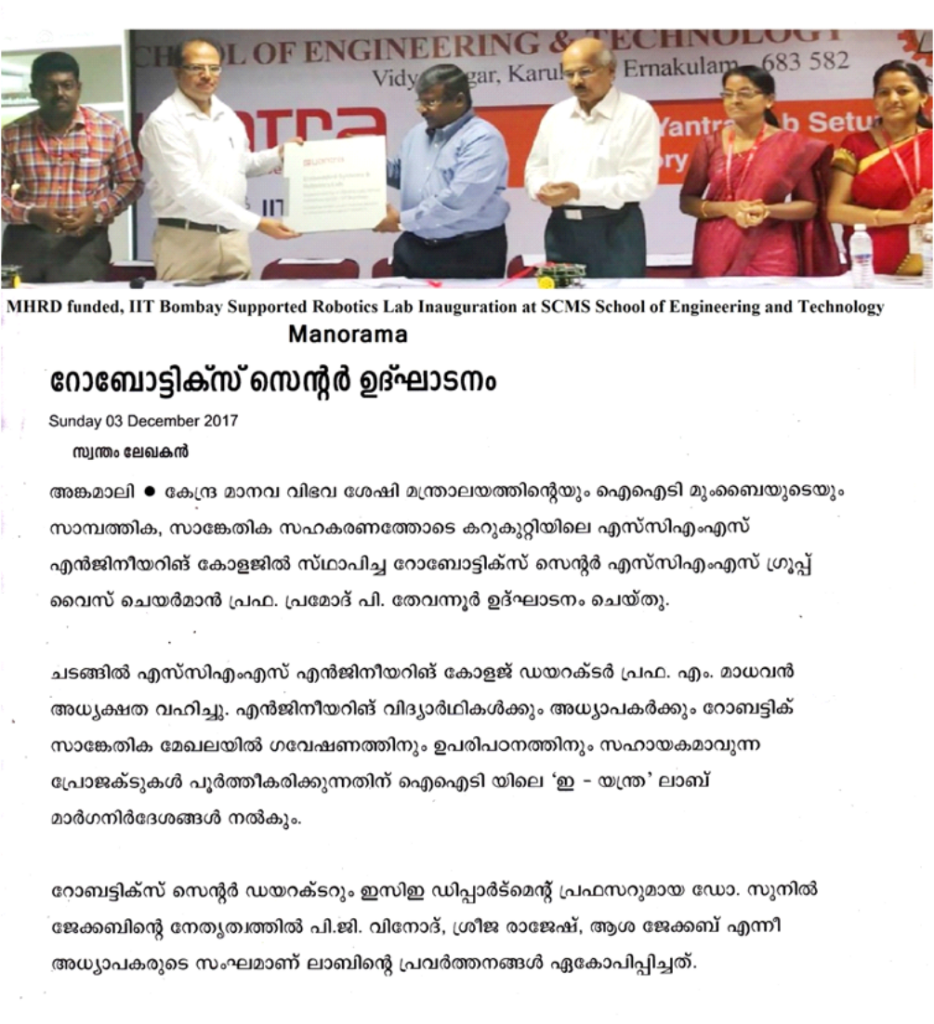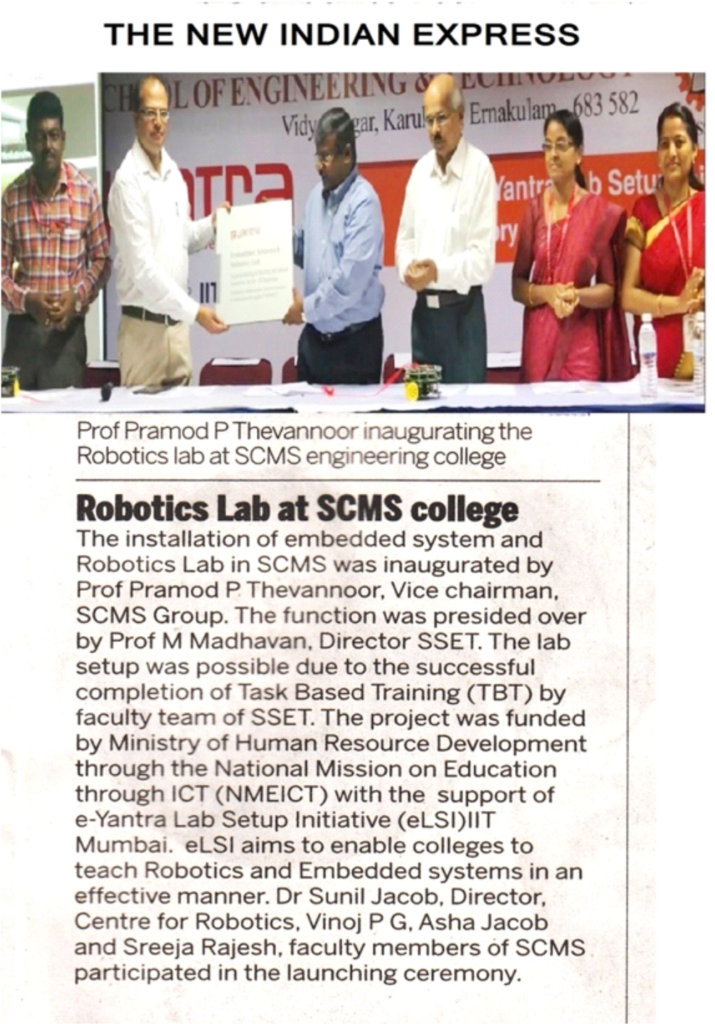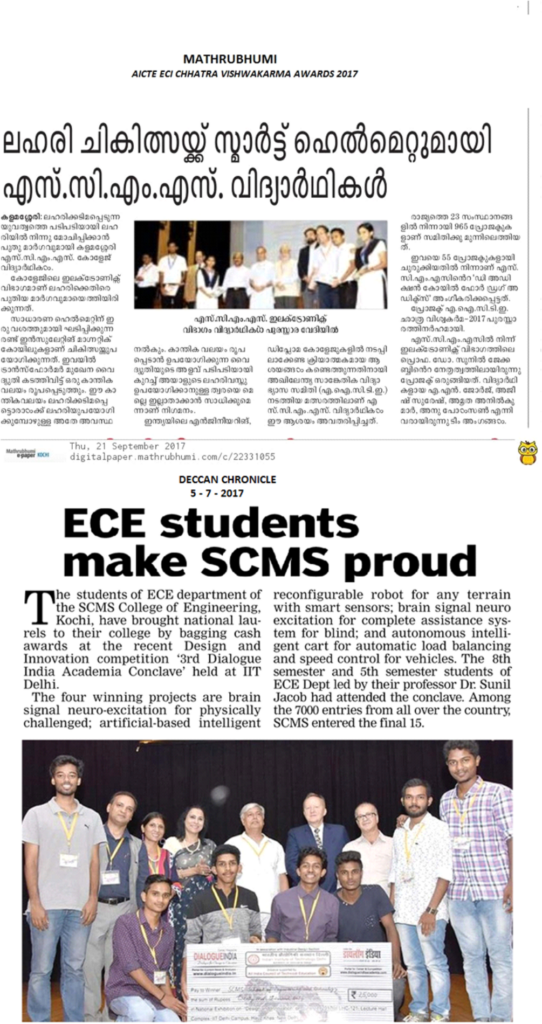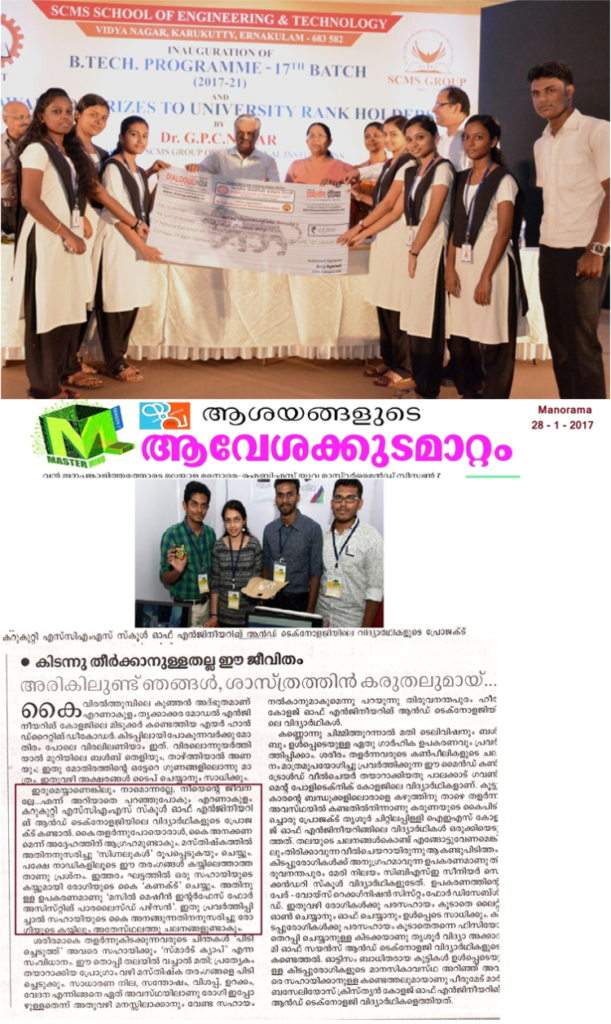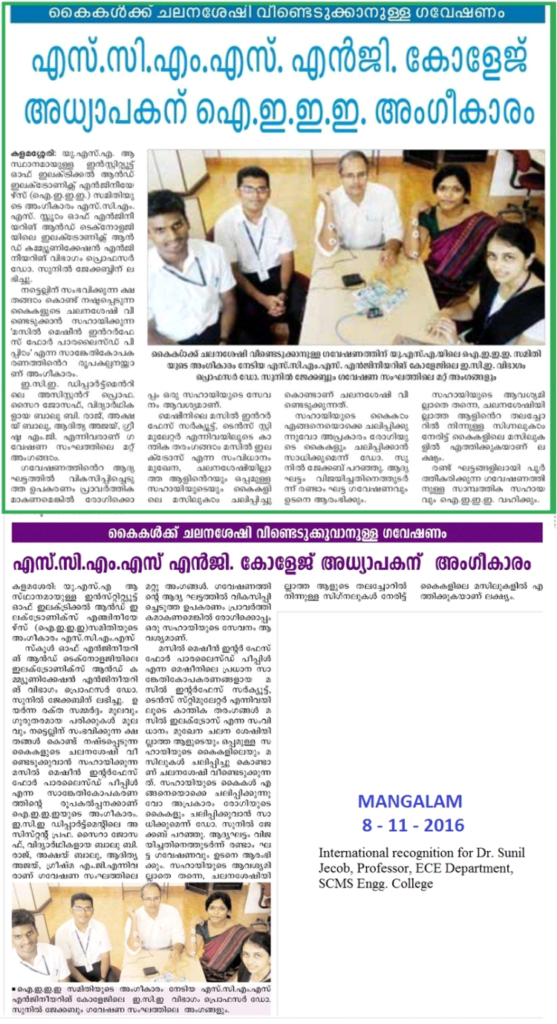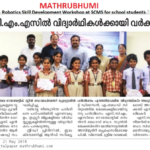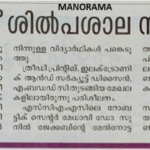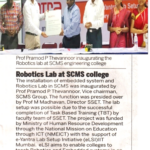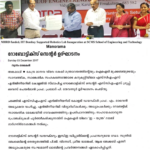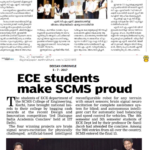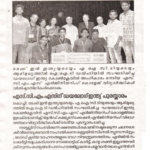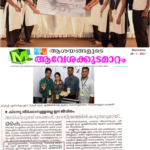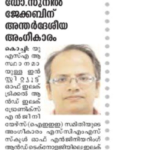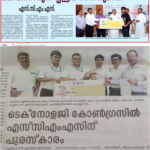Research Cell
SSET has been looking for new avenues to expand; and research is one such which it has been lately focusing on. Strengthening research is one of its objectives towards pursuit of excellence. It has a well-established research cell run by coordinators from various disciplines. The research activities of SSET are based on a well-defined policy making possible the carryout of unified research practices at the institution. It has been mainly focusing on multi-disciplinary projects which are the need of the hour. The faculty and students are also involved in projects of societal impact and socio-economic concern.
Robotics
Welcome to the SCMS Centre for Robotics!
Situated within the esteemed SCMS School of Engineering & Technology, we are your go-to hub for all things robotics. Whether you’re an engineering student, a budding inventor, or a seasoned researcher, we’ve got something for everyone!
A Glimpse into the Future
At the SCMS Centre for Robotics, our vision is to evolve into a Global Centre for Robotics that pioneers the development of autonomous, innovative, and reconfigurable robotic technologies. We aim to establish robotic systems powered by artificial intelligence that can operate intelligently without human supervision. Our vision extends beyond technology; we aspire for these robotic systems to work harmoniously with humans across various sectors and contribute to a wide range of services and labor. In essence, we envision a future where robotics permeates every sphere of human activity, enhancing quality of life and driving innovation.
The Roadmap to Our Vision
Our mission serves as the strategic framework that guides us toward our vision. We are committed to understanding the science, engineering, and social implications of robotics and embedded intelligence through rigorous research. We adopt an interdisciplinary approach, coordinating efforts to address both the technical and non-technical aspects of modern robotics. In the medium term, our focus is on bio-inspired robot design, human-robot interaction, and Swarm Robotics. As we expand our domain expertise, we are also committed to undertaking long-term projects in various other areas that promise to push the boundaries of what is possible in the field of robotics.
Formulation of the Goal: We engage in high-level thinking to determine what we aim to accomplish. It’s about setting the stage for what’s to come.
Formulation of the Intention:We narrow down our focus to specify what will satisfy the overarching goal. It’s about fine-tuning our aim.
Specification of the Action: This involves outlining the necessary actions to achieve the intention. Each action is planned to be carried out sequentially.
Execution of the Action: We physically implement the planned actions. In computer terms, this involves executing the necessary commands.
Perception of the System State: Post-execution, it’s crucial to assess what has occurred. This involves noticing any changes or results that have come about.
Interpretation of the System State: After perceiving the system state, we use our knowledge to interpret what these changes signify.
Evaluation of the Outcome: Finally, we compare the system state, as perceived and interpreted, with the initial intention to decide if progress has been made and to plan the next steps.
Action Plan for Year 2019
Formulation of the Goal: The primary aim for 2019 is to develop the first version of the “SCMS Humanoid” that closely mimics human characteristics.
Formulation of the Intention: The initial step in this grand plan is to design a 3D-printed Humanoid. This design will incorporate sensors for various functionalities.
Budget Considerations: The cost for this project is effectively zero, thanks to the facilities provided by the SCMS-FAB lab.
Director’s Profile
Dr. Sunil Jacob
Position: Director, SCMS Centre for Robotics & Professor, ECE Dept. Role: The driving force behind the Centre for Robotics, Dr. Sunil Jacob has been an inspiration to budding engineers through his dedication, hard work, and innovative inventions. Academic Qualifications: PhD in Department of Electronics- Areas of Expertise: Electronics
| Year | Award Title | Project Title |
| 2020 | Gandhian Young Technological And Innovation Awards (GYTI-2020) | Artificial Deep Learning Brain Actuated Lower Limb Exoskeleton for Paralyzed |
| 2018 | Young Gandhian Technological Innovation Appreciation Award | Brain wave nerve excitation for physically disabled |
| 2017 | AICTE Chathra Vishvakarma Award in Electronics | A DE addictive coil for drug addicts |
| 2018 | Nautilus 2018 First Prize | N/A |
| 2018 | SASTRAYAAN 2018 Award | Muscle to Machine Interface for Paralyzed Person (MMIPP) Ver.2 |
| 2017 | Manorama Yuva Mastermind 2017 | Wearable Device for Prevention and Detection of Heart Failure |
| 2017 | Third Dialogue India Academia Conclave (IIT, DELHI), 3rd Prize | Various Projects |
| 2016 | KETKON-TECHFEST-2016 of KSCSTE | Bionic Haptic Arm |
List Of Publications
| Sl.no | Title of the Paper | Conference/Seminar Volume | Year of Publication | Publisher |
| 1 | Intelligent vehicle collision avoidance system using 5G-enabled drone swarms | Proceedings of the 2nd ACM MobiCom Workshop on Drone Assisted Wireless Communications for 5G and Beyond 91-96 | Sept 2020 | ACM |
| 2 | A secure and energy-efficient opportunistic routing protocol with void avoidance for underwater acoustic sensor networks | Turkish Journal of Electrical Engineering & Computer Sciences 28 (4), 2303-2315E | 2020 | Turkish Journal |
| 3 | An Adaptive and Flexible Brain Energized Full Body Exoskeleton With IoT Edge for Assisting the Paralyzed Patients | IEEE Access 8, 100721 –100731 | 2020 | IEEE |
| 4 | An IoT-Enabled Intelligent Automobile System for Smart Cities | Internet of Things | 2020 | ELSEVIER |
| 5 | A Low-cost Preventive Face Shield and Reusable N95 Compatible Mask for Preventing the Spread of COVID-19 VGM | IEEE Future Directions | 2020 | IEEE |
| 6 | Bidirectional Multi-tier Cognitive Swarm Drone 5G Network | IEEE Conference on Computer Communications (INFOCOM) | 2020 | IEEE |
| 7 | Depth Information Enhancement Using Block Matching and Image Pyramiding Stereo Vision Enabled RGB-D Sensor | IEEE Sensors Journal | 2020 | IEEE |
| 8 | A Novel Spectrum Sharing Scheme using Dynamic Long Short-Term Memory with CP-OFDMA in5G Networks | IEEE Transactions on Cognitive Communications and Networking | 2020 | IEEE |
| 9 | SDN Powered Humanoid with Edge Computing for Assisting Paralyzed Patients | AOAVA Authors IEEE Internet of Things Journal ( Early Access) | 2019 | IEEE |
| 10 | Secure Brain to Brain Communication with Edge Computing for Assisting Post-Stroke Paralyzed Patients | V P,IEEE Internet of Things Journal | 2019 | IEEE |
| 11 | Artificial Intelligence Powered EEG-EMG Electrodes for Assisting the Paralyzed | IEEE Future Directions | 2019 | IEEE |
| 12 | Hybrid brain actuated muscle interface for the physically disabled | Basic & Clinical Pharmacology & Toxicology | August 2018 | WILEY |
| 13 | Camotransmutees | Proceedings of National Conference on “Design & Innovation” | 2018 | Dialogue India held at IIT, Delhi |
| 14 | Time-Domain Chacterization of Dual Band Spiral Antenna with WMTS/UWB Application | International Journal of Antennas and Propagation.,Volume 2017, Article ID 2301751, 6 pages- Indexed by SCIE | 2017 | Hindawi |
| 15 | A Review of Technology Advances for Assisting Paralyzed People [Leading Edge] | IEEE Technology and Society Magazine ( Volume: 36, Issue: 2, June 2017 ) Indexed by SCIE | 2017 | IEEE Technology and Society Magazine |
| 16 | Brain to Muscle interface for Paralysed person (BMIP) interface | Research Project | 2017 | IEEE Tasmitter |
| 17 | Investigation of double negativity of SRR-thin wire structures | Control Communication & Computing India (ICCC), 2015 International Conference | Nov. 2015 | IEEE |
| 18 | Random Access OFDMA Network With Dynamic Resource Allocation | International Conference on Data Storage and Data Engineering pp-15-19,DSDE, India, Print ISBN: 978-0-7695-3958-4. DOI-10.1109/DSDE.2010.27. | February 2010 | Publisher IEEE DOI: 10.1109/DSDE.2010.27 |
| 19 | Random Access OFDMA Network with Dynamic Resource Allocation using Regenerative Decode and Forwarding Protocol with Rayleigh Fading Channel | International Conference on Recent Trends in Information, Telecommunication and Computing) pp-85-89,ITC, Tyre1India,Print ISBN:978-1-4244-59568DOI10.1109/ITC. | March 2010 | Publisher IEEE DOI: 10.1109/ITC.2010.53 |
| 20 | Investigation of double negativity of SRR-thin wire structures | 2015 International Conference on Control Communication & Computing India (ICCC) | 19-21 Nov 2015 | DOI:10.1109/ICCC.2015.7432942 Publisher: IEEE |
| 21 | Enabling Coexistence of ZigBee and WiFi | CAE) – ISSN : 2394-4714 Volume 2 – No.6 | 2016 | Communications on Applied Electronics |
| 22 | Design of a Low Voltage low Power Double tail comparator in 180nm CMOS Technology | e-ISSN : 2320-0847 p-ISSN : 2320-0936 Volume-3, Issue-9, pp-15-19 | 2014 | American Journal of Engineering Research(AJER) |
| 23 | Dynamic Source Quick Route Rebuilding Algorithm For Random-Access OFDMA Adhoc Network | Volume 37– No.9 | Jan 2012 | International Journal of Computer Applications |
| 24 | Low Power Critical Path Redesigned Ecrl Pipeline Implementation | ISSN: 22311963 | 2015 | International Journal of Advances in Engg& Tech |
| 25 | Energy Efficient TRDMA over Multipath Channels | ISSN : 2394-4714 Volume 2 – No.7 | August 2015 | CAE Foundation of Computer Science FCS, New York, USA |
| 26 | Cooperative Cross Layer Solution for Performance Improvement in Wireless OFDMA Network |
| Sl.no | Title of the Book | Conference/Seminar Volume | Year of Publication | Publisher |
| 1 | Wireless Technology First Edition | 176/ISBN-13:978-3-659-43286-6 | March 2015 | Lambert Academic publisher, Germany |
| Title of the Book | Co-Authored By | Licensed By | Publisher |
| 4G Wireless Communication using MATLAB | Asha Jacob | MAT Lab | Cambridge Scholar |
Research Supervision
| Supervisor | Ph.D Scholar | Research Topic |
| SUNIL JACOB | Praveena S Kammath | EC Engineering |
| SUNIL JACOB | Vrinda V Gopal T | EC Engineering |
| SUNIL JACOB | Vinoj P G | Embedded System, Robotics |
Ongoing Projects
Artificial Skin
Bio Mimicked robots
Moisture detection in grains
Project Humanoid
Project Paddy
Reef waste Management System
S.H.E.P.A.R.D
Weather Station
| Sl. No | Year | Title of Invention | Application Number | Applicant Name |
| 1 | 16-11-2018 | Self Assistive Brain Body Control Physiotherapy Device | 201841042113 | Dr. Sunil Jacob |
| 2 | 16-11-2018 | DE-ADDiCTO (Non-Invasive Anti-Depression and Drug Rehab E-M Stimulator) | 201841042115 | Dr. Sunil Jacob |
| 3 | 28-09-2018 | MEDICOS (Medical Kiosk: A Mini Virtual Hospital for Villages) | 201841034922 | Dr. Sunil Jacob |
Funding and Inauguration of the Robotics Lab
Funding and Inauguration of the Robotics Lab
A Milestone in Robotics Education
The SCMS Centre for Robotics has been a beacon of innovation and education in the field of robotics. This journey has been made possible through significant funding and support. The Centre received a substantial boost from the Ministry of Human Resource Development (MHRD) through the e-Yantra project, an initiative led by IIT Bombay. This funding was instrumental in equipping the Robotics Lab with state-of-the-art facilities.
A Competitive Edge
The lab setup was not just a matter of financial backing but also a testament to the Centre’s excellence. The faculty team from SSET, led by Dr. Sunil Jacob, competed with 150 colleges on a PAN India basis and successfully completed the Task-Based Training (TBT), thereby securing the funding and support.
Team Behind the Success
- Team Leader: Dr. Sunil Jacob
- Team Members:
- Mr. Vinoj P G, Assistant Professor, ECE
- Ms. Sreeja Rajesh, Assistant Professor, CSE
- Ms. Asha Jacob, Lab Assistant, CSE
A Grand Inauguration
The formal inauguration of the Embedded System and Robotics Lab was a landmark event. It was graced by Prof. Pramod P Thevannoor, Vice Chairman of the SCMS Group, and presided over by Prof. M Madhavan, Director of SSET. The symbolic inauguration involved the handover of the lab signage to Dr. Sunil Jacob, marking a new chapter in the Centre’s journey.
Captured Moments
In a memorable photograph capturing the essence of this milestone, from left to right, are Mr. Vinoj P.G, Dr. Sunil Jacob, Prof. Pramod P Thevannoor, Prof. M Madhavan, Ms. Asha Jacob, and Ms. Sreeja Rajesh.
This funding and the subsequent lab setup symbolize not just financial investment but also the collective vision, hard work, and competitive spirit that make the SCMS Centre for Robotics a leading institution in the field.
| SL NO | Title of Project | Funding Agency | Year |
| 1 | Prediction Analysis and Smart Mask Based on Social Distancing System | Research Council, Oman | 2019-20 |
| 2 | Artificial Deep Learning Brain Actuated Lower Limb Exoskeleton for Paralyzed | SRISTI | 2019-20 |
| 3 | Solar-Powered Smart Mask Disposable Unit | SCMS | 2019-20 |
| 4 | Smart Switching Toilet System | IEEE SIGHT | 2018-19 |
| 5 | Bug-Bot with Mosquito Attracter | KSCSTE | 2017-18 |
| 6 | Smart Mop with Infrared Thermography | Malayala Manorama | 2017-18 |
| 7 | Muscles to Machine Interface for Paralyzed | KSCSTE, IEEE EPICS, USA, Malayala Manorama | 2015-17 |
| 8 | Wearable Device for Detection and Prevention of Heart Failure | KSCSTE, Malayala Manorama | 2015-17 |
| 9 | Eco-Friendly and Energy-Efficient Traffic Junctions | KSCSTE | 2015-16 |
| 10 | Low-Cost 3D Printer | SSET | 2015-16 |
| 11 | Brain to Brain Interface for All Living Beings | SSET in Collaboration with Backyard Brain and Neurosky | 2015-16 |
| 12 | Bionic Haptic Arm | KSCSTE | 2015-16 |
SCMS Innovations for Public Health and Safety [Covid -19]
SCMS Biodegradable Disposal Unit for Used Masks and Gloves
Overview:
In a world grappling with the COVID-19 pandemic, the safe disposal of used masks and gloves is a concern. SCMS has developed a three-stage unit that not only sanitizes these items but also ensures they are safe for sanitation workers to handle.
How it Works:
- Sanitizing Spray: Initially, the masks and gloves are sprayed with a sanitizing liquid.
- UV Light Treatment: They are then subjected to UV light for further disinfection.
- Heating: Finally, the items are heated to ensure complete sanitization.
Additional Features:
- Made of biodegradable material.
- Features a removable tray for easy waste removal.
- Solar-powered, making it eco-friendly.
SCMS Disinfecting Box
Overview:
A cost-effective UV-C light-based device designed to disinfect everyday items like keys, wallets, and money, thereby helping to curb the spread of COVID-19.
Safety Feature:
The UV lamp automatically turns OFF if the door is accidentally opened during operation, ensuring user safety.
Additional Features:
- Entirely designed and developed at SCMS Fablab.
- Costs less than 1000 rupees, making it affordable for the general public.
Automatic Respiratory Assistance for Ventilator
Overview:
A sophisticated system that adjusts the compression of the ambu bag in ventilators by analyzing the patient’s breathing rate, thereby providing customized respiratory assistance.
SCMS Automatic Sanitizer Dispenser
Overview:
A low-cost, hands-free system that dispenses sanitizer when a hand is brought near the nozzle, making it ideal for public places.
Additional Features:
- User avoids physical contact with the dispenser, ensuring safety.
3D Printed Personal Protective Equipment
Overview:
SCMS has also ventured into the production of 3D printed masks, face shields, and Y-splitters, contributing to the pool of essential PPE during these challenging times.
These innovations not only showcase the technical prowess of SCMS but also its commitment to public health and safety.
Achievements of SCMS Centre for Robotics
The SCMS Centre for Robotics has been a beacon of innovation and excellence, garnering numerous accolades and awards that reflect its commitment to technological advancement and social impact. Here are some of the notable achievements:
Awards and Recognitions
- Social Innovation Challenge: A testament to the Centre’s focus on creating socially impactful solutions.
- Gandhian Young Technological And Innovation Awards: Received in both 2020 (GYTI – 2020) and 2018 (GYTI – 2018), these awards highlight the Centre’s dedication to technological innovation inspired by Gandhian principles.
- Sastrayaan 2018 CUSAT: Recognized for excellence in scientific and technological innovation at the Cochin University of Science and Technology.
- AICTE Chathra Vishvakarma Award 2017 in Electronics: An award that underscores the Centre’s prowess in electronics and engineering.
- Third Dialogue India Academia Conclave (IIT, Delhi), 2017: A prestigious recognition from one of India’s leading engineering institutes.
- IEEE EPICS, USA 2017: An international accolade that speaks to the Centre’s global standing in engineering projects in community service.
- Manorama Yuva Mastermind 2017: An award that celebrates the Centre’s young and innovative minds.
- TBT Challenge 2017: Acknowledgment for the Centre’s task-based training competencies.
- e-Yantra Robotics Competition (eYRC) 2017 and e-Yantra Ideas Competition (eYIC) 2018: Awards that showcase the Centre’s expertise in robotics.
- KSCSTE & KTU – Technological Congress 2016: Recognition for contributions to technological advancements in the state of Kerala.
Programmes Offered by SCMS Centre for Robotics
Internship Programme On Robotics And Automation 2019
- Objective: This internship aims to provide students with real-world experience in the fields of robotics and automation.
- Duration: Not specified, but typically internships in this field range from 4 to 12 weeks.
- Activities: The programme covers a wide range of topics including PLC, SCADA, and HMI systems, along with industrial visits and hands-on project work.
- Outcome: Interns are expected to gain both theoretical knowledge and practical skills, preparing them for industrial roles in robotics and automation.
- Source: Daffodil Internship Report 2019
Robotics Skill Development Workshop 2019
- Objective: The workshop is designed to offer hands-on experience in robotics and automation.
- Duration: 5 days
- Activities: The curriculum includes an introduction to robotics, Arduino programming, Internet of Things (IoT), and machine learning.
- Outcome: Participants will have the opportunity to develop small projects, gaining practical experience in robotics.
- Source: Robotics Skill Development Workshop 2019
Robotics Skill Development Workshop 2018
- Objective: This workshop aims to introduce school students to the world of robotics.
- Duration: 14 days
- Activities: The workshop includes lab visits and hands-on sessions in electronics, automobile, mechanical, and computer labs. Students also engage in idea presentation sessions.
- Outcome: The workshop equips students with the basic knowledge required to develop a project from scratch.
- Source: Robotics Skill Development Workshop 2018
FAB LAB, Robotics & IOT Workshop – 2018
- Objective: The workshop aims to educate faculty and students from Polytechnics about FAB Lab, Robotics, and IoT.
- Duration: 2 days
- Activities: Participants are introduced to electronic components, 3D and 2D printing, IoT & Sensors, Embedded C & Firebird V. The workshop also includes hands-on sessions.
- Outcome: Participants are expected to gain hands-on experience and are encouraged to build a Fab Lab on their own campus.
- Source: FAB LAB, Robotics & IOT Workshop – 2018
These programmes are part of the SCMS Centre for Robotics’ commitment to fostering education and skill development in the field of robotics and automation.
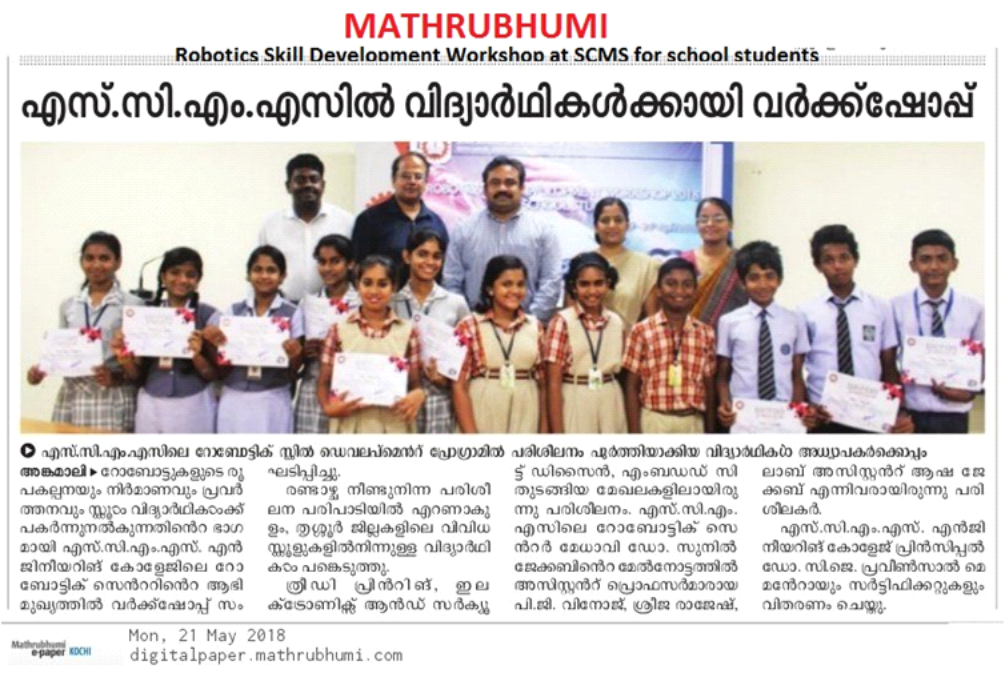
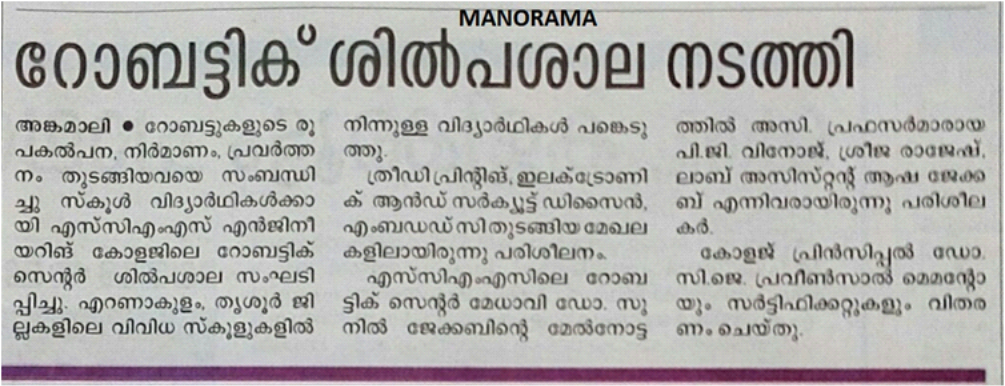
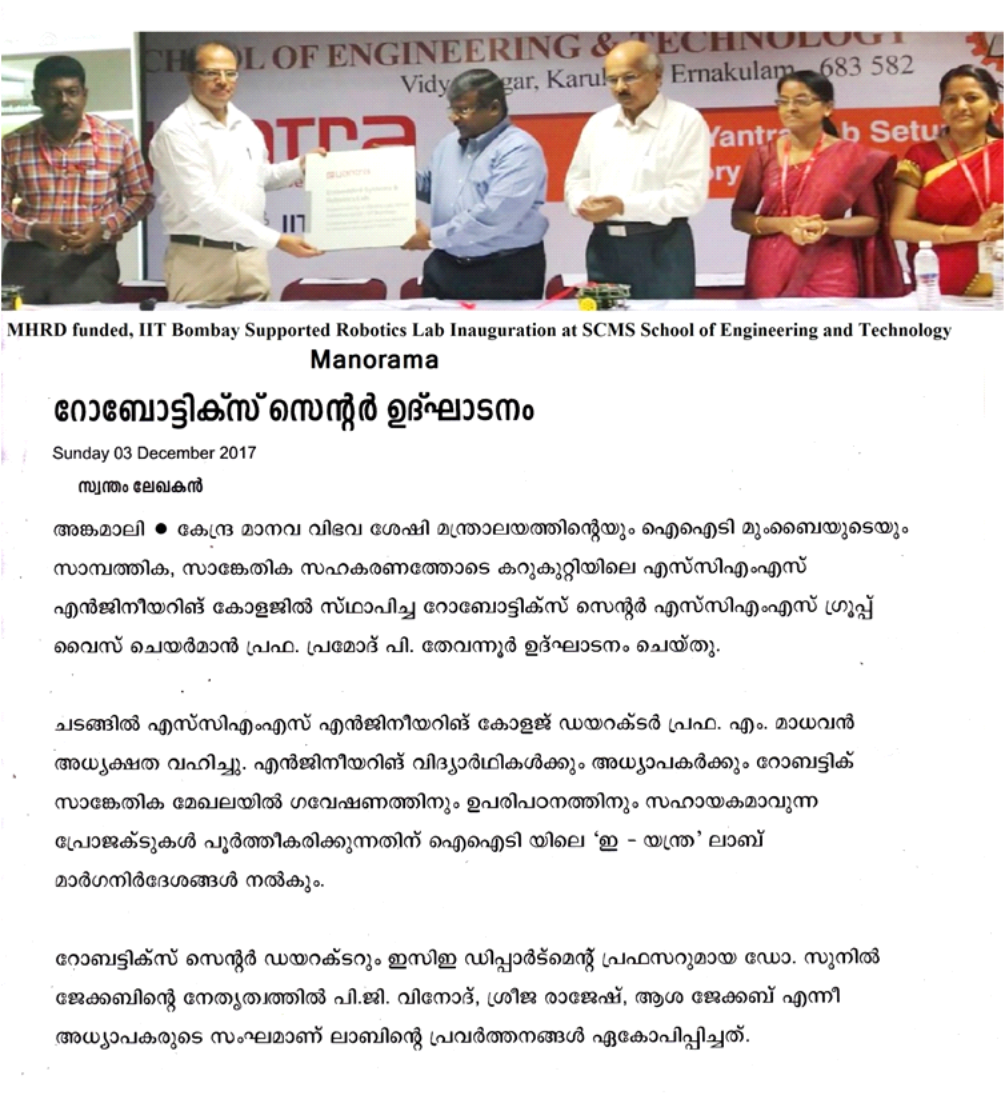
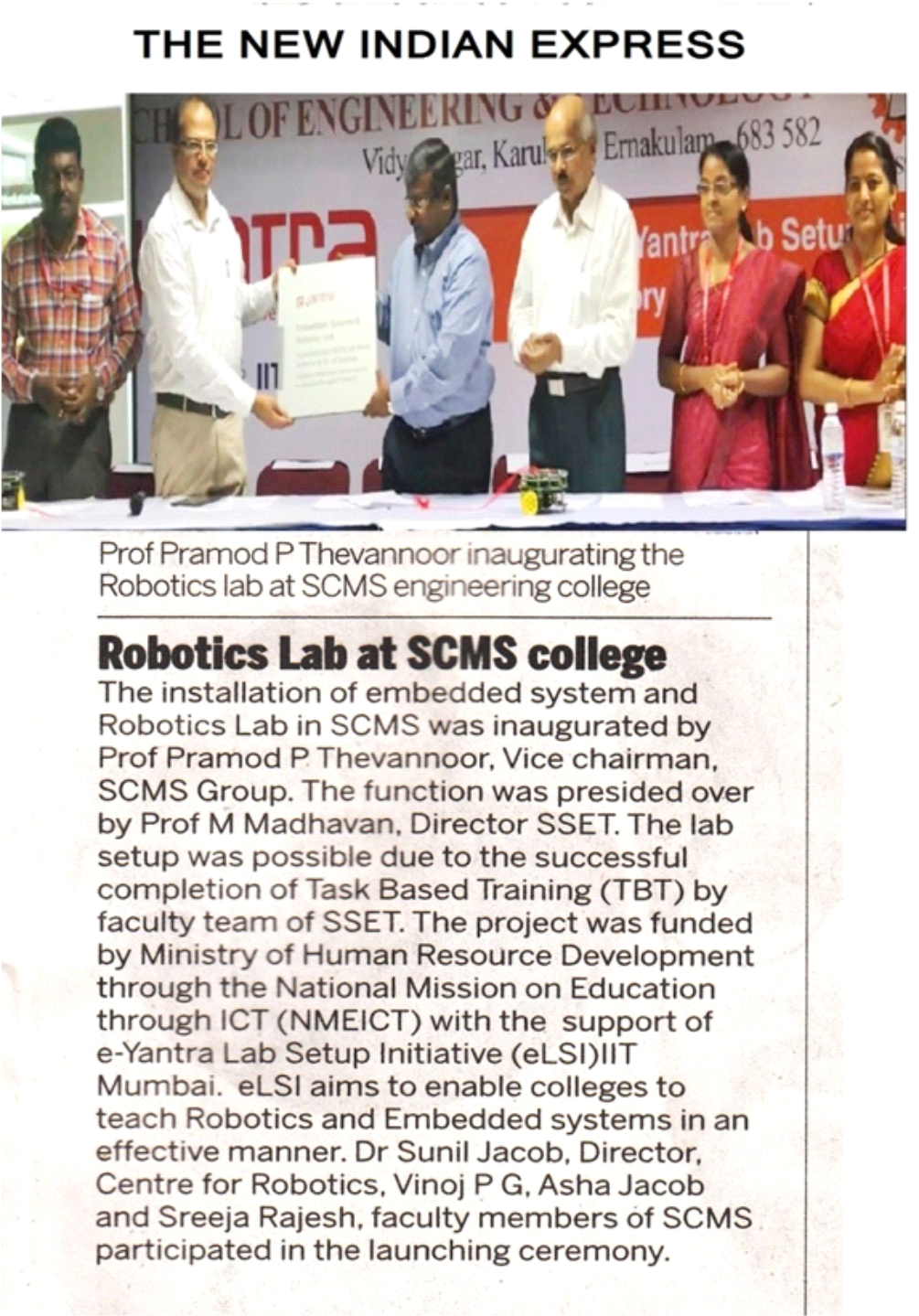
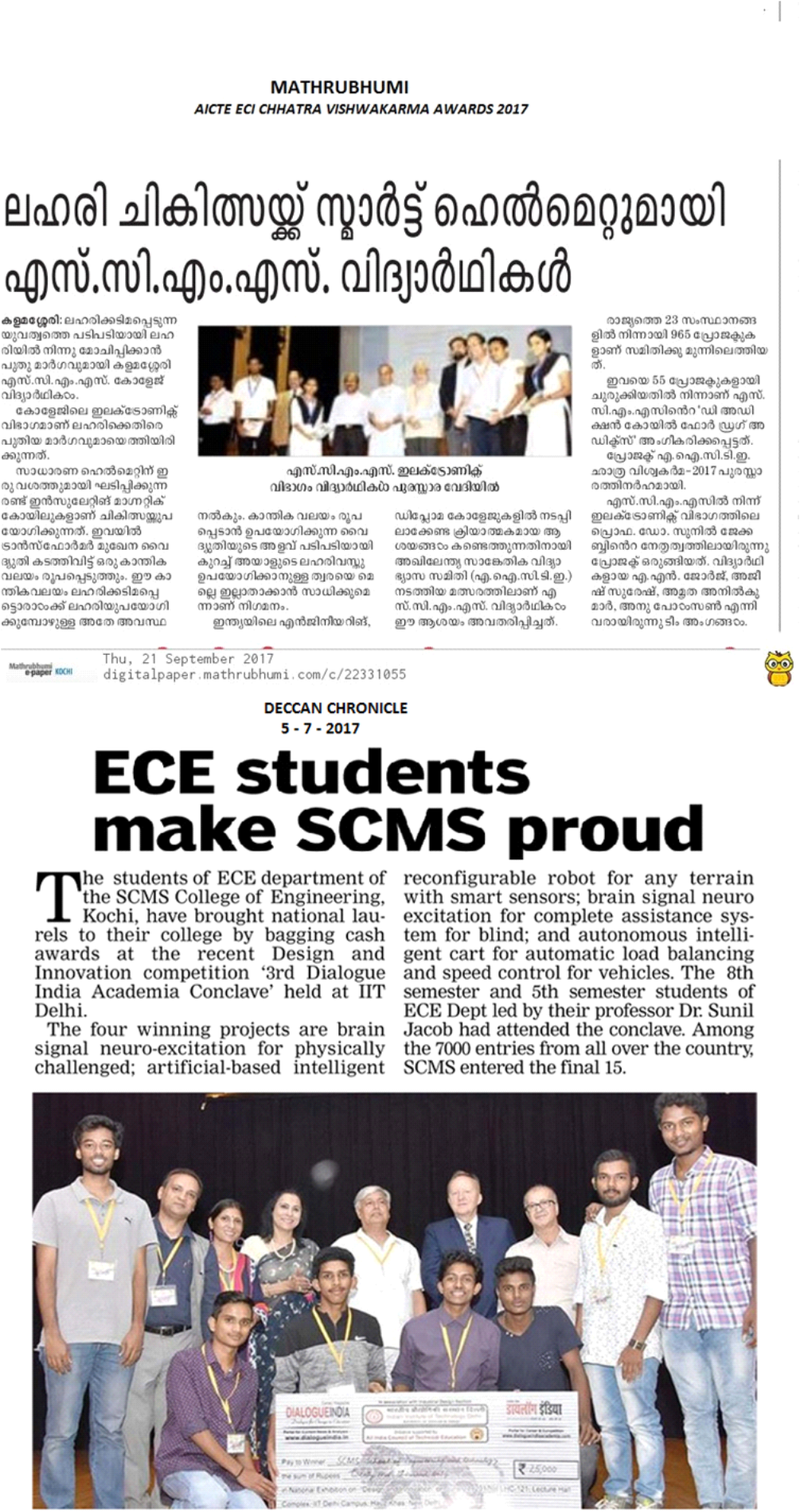
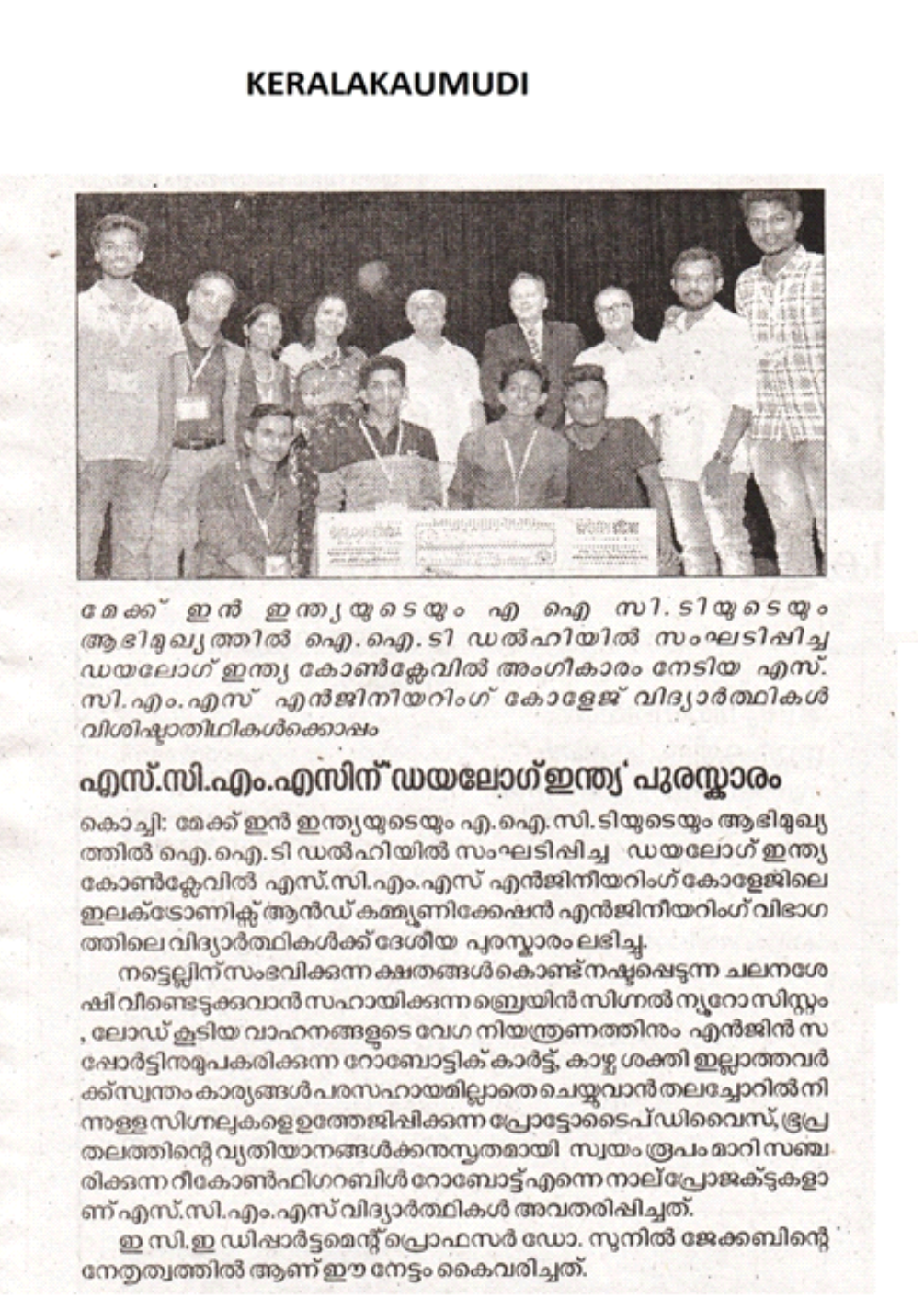
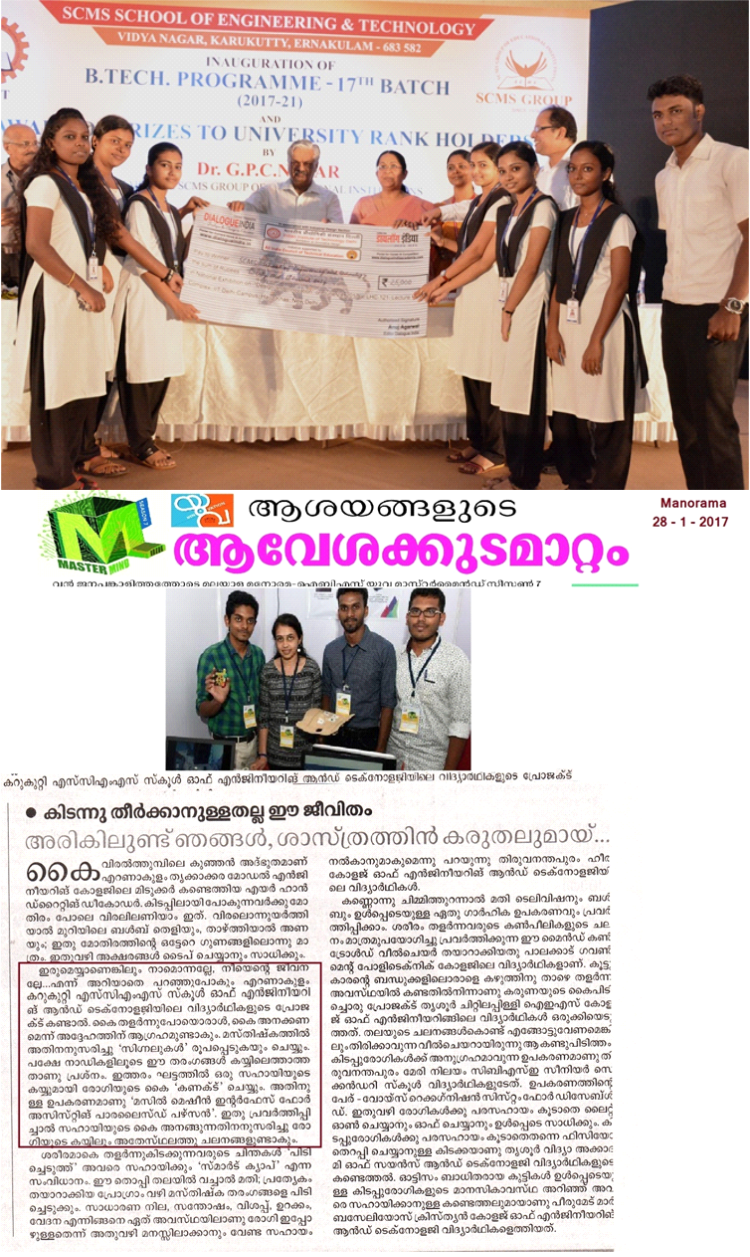
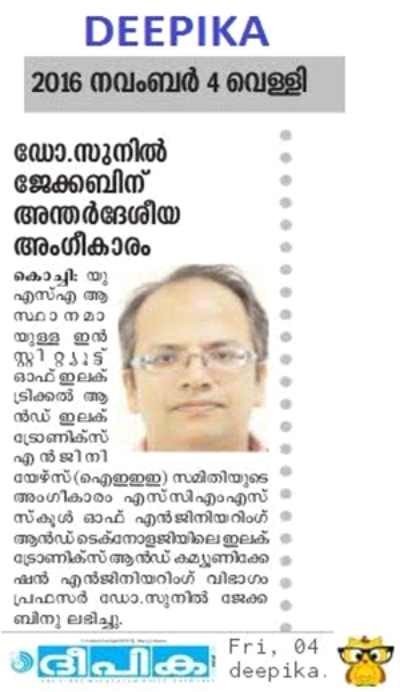

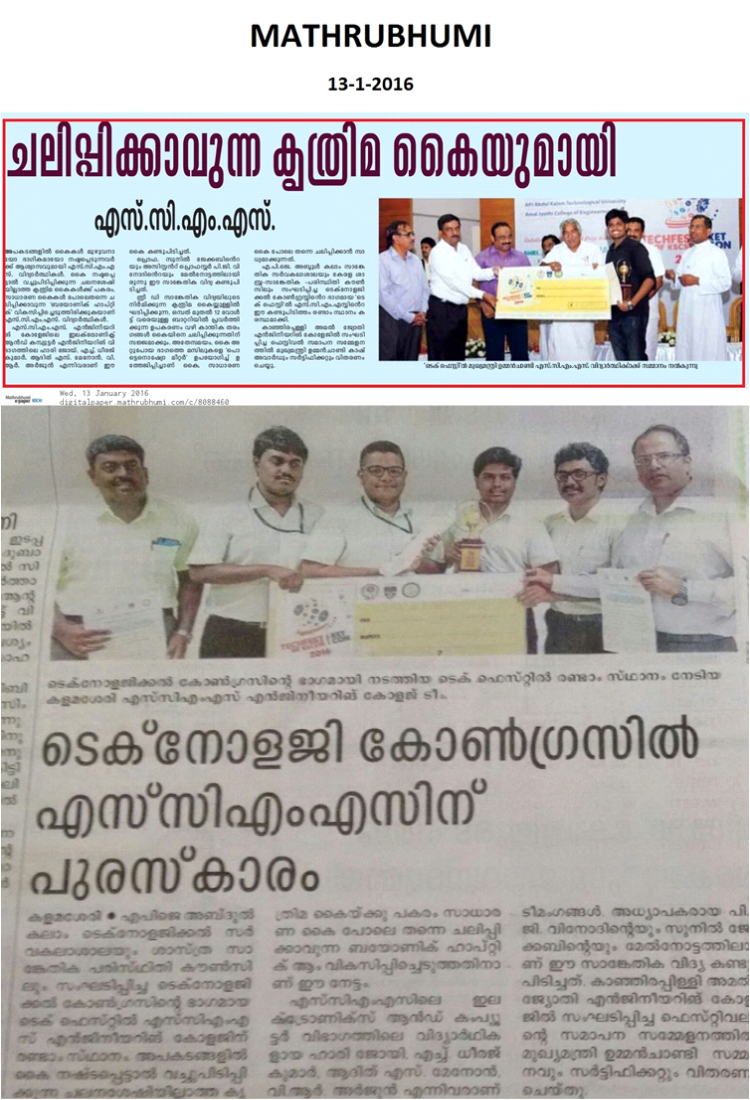
Contact Details
SCMS Centre for Robotics
SCMS School of Engineering and Technology
Vidya Nagar, Karukutty, Ernakulam, Kerala, India
Email: sset@scmsgroup.org
Phone: +91 70347 80074
Robotics
Center For Robotics
Welcome To The SCMS Centre For Robotics!
Situated within the esteemed SCMS School of Engineering & Technology, we are your go-to hub for all things robotics. Whether you’re an engineering student, a budding inventor, or a seasoned researcher, we’ve got something for everyone!
Vision & Mission
A Glimpse Into The Future
At the SCMS Centre for Robotics, Our vision is to evolve into a Global Centre for Robotics that pioneers the development of autonomous, innovative and reconfigurable robotic technologies. We aim to establish robotic systems powered by artificial intelligence that can operate intelligently without human supervision. Our vision extends beyond technology; we aspire for these robotic systems to work harmoniously with humans across various sectors and contribute to a wide range of services and labor. In essence, we envision a future where robotics permeates every sphere of human activity, enhancing quality of life and driving innovation.
The Roadmap to Our Vision
Our mission serves as the strategic framework that guides us toward Our vision. We are committed to understanding the science, engineering, and social implications of robotics and embedded intelligence through rigorous research. We adopt an interdisciplinary approach, coordinating efforts to address both the technical and non-technical aspects of modern robotics. In the medium term, our focus is on bio-inspired robot design, human-robot interaction and Swarm Robotics. As we expand our domain expertise, we are also committed to undertaking long-term projects in various other areas that promise to push the boundaries of what is possible in the field of robotics.
Action Specification
Formulation Of The Goal: We engage in high-level thinking to determine what we aim to accomplish. It’s about setting the stage for what’s to come.
Formulation Of The Intention: We narrow down our focus to specify what will satisfy the overarching goal. It’s about fine-tuning our aim.
Specification Of The Action: This involves outlining the necessary actions to achieve the intention. Each action is planned to be carried out sequentially.
Execution Of The Action: We physically implement the planned actions. In computer terms, this involves executing the necessary commands.
Perception Of The System State: Post-execution, it’s crucial to assess what has occurred. This involves noticing any changes or results that have come about.
Interpretation Of The System State: After perceiving the system state, we use our knowledge to interpret what these changes signify.
Evaluation Of The Outcome: Finally, we compare the system state, as perceived and interpreted, with the initial intention to decide if progress has been made and to plan the next steps.
Action Plan For Year 2019
Formulation Of The Goal: The primary aim for 2019 is to develop the first version of the “SCMS Humanoid” that closely mimics human characteristics.
Formulation Of The Intention: The initial step in this grand plan is to design a 3D-printed Humanoid. This design will incorporate sensors for various functionalities.
Budget Considerations: The cost for this project is effectively zero, thanks to the facilities provided by the SCMS-FAB lab.
Director’s Profile
Dr. Sunil Jacob
Position: Director, SCMS Centre for Robotics & Professor, ECE Dept.
Role: The driving force behind the Centre for Robotics, Dr. Sunil Jacob has been an inspiration to budding engineers through his dedication, hard work, and innovative inventions.
Academic Qualifications: PhD in Department of Electronics
Areas Of Expertise: Electronics
Awards Received
| Year | Award Title | Project Title |
|---|---|---|
| 2020 | Gandhian Young Technological And Innovation Awards (GYTI-2020) | Artificial Deep Learning Brain Actuated Lower Limb Exoskeleton for Paralyzed |
| 2018 | Young Gandhian Technological Innovation Appreciation Award | Brain Wave Nerve Excitation for Physically Disabled |
| 2017 | AICTE Chathra Vishvakarma Award in Electronics | A De-addictive Coil for Drug Addicts |
| 2018 | Nautilus 2018 First Prize | N/A |
| 2018 | SASTRAYAAN 2018 Award | Muscle to Machine Interface for Paralyzed Person (MMIPP) Ver.2 |
| 2017 | Manorama Yuva Mastermind 2017 | Wearable Device for Prevention and Detection of Heart Failure |
| 2017 | Third Dialogue India Academia Conclave (IIT, DELHI), 3rd Prize | Various Projects |
| 2016 | KETKON-TECHFEST-2016 of KSCSTE | Bionic Haptic Arm |
List Of Publications
| Sl.no | Title of the Paper | Conference/Seminar Volume | Year of Publication | Publisher |
|---|---|---|---|---|
| 1 | Intelligent Vehicle Collision Avoidance System Using 5G-Enabled Drone Swarms | Proceedings of the 2nd ACM MobiCom Workshop on Drone Assisted Wireless Communications for 5G and Beyond 91-96 | Sept 2020 | ACM |
| 2 | A Secure and Energy-Efficient Opportunistic Routing Protocol With Void Avoidance For Underwater Acoustic Sensor Networks | Turkish Journal of Electrical Engineering & Computer Sciences 28 (4), 2303-2315E | 2020 | Turkish Journal |
| 3 | An Adaptive and Flexible Brain Energized Full Body Exoskeleton With IoT Edge for Assisting the Paralyzed Patients | IEEE Access 8, 100721 –100731 | 2020 | IEEE |
| 4 | An IoT-Enabled Intelligent Automobile System for Smart Cities | Internet of Things | 2020 | ELSEVIER |
| 5 | A Low-cost Preventive Face Shield and Reusable N95 Compatible Mask for Preventing the Spread of COVID-19 VGM | IEEE Future Directions | 2020 | IEEE |
| 6 | Bidirectional Multi-tier Cognitive Swarm Drone 5G Network | IEEE Conference on Computer Communications (INFOCOM) | 2020 | IEEE |
| 7 | Depth Information Enhancement Using Block Matching and Image Pyramiding Stereo Vision Enabled RGB-D Sensor | IEEE Sensors Journal | 2020 | IEEE |
| 8 | A Novel Spectrum Sharing Scheme using Dynamic Long Short-Term Memory with CP-OFDMA in5G Networks | IEEE Transactions on Cognitive Communications and Networking | 2020 | IEEE |
| 9 | SDN Powered Humanoid with Edge Computing for Assisting Paralyzed Patients | AOAVA Authors IEEE Internet of Things Journal ( Early Access) | 2019 | IEEE |
| 10 | Secure Brain to Brain Communication with Edge Computing for Assisting Post-Stroke Paralyzed Patients | V P,IEEE Internet of Things Journal | 2019 | IEEE |
| 11 | Artificial Intelligence Powered EEG-EMG Electrodes for Assisting the Paralyzed | IEEE Future Directions | 2019 | IEEE |
| 12 | Hybrid brain actuated muscle interface for the physically disabled | Basic & Clinical Pharmacology & Toxicology | August 2018 | WILEY |
| 13 | Camotransmutees | Proceedings of National Conference on “Design & Innovation” | 2018 | Dialogue India held at IIT, Delhi |
| 14 | Time-Domain Chacterization of Dual Band Spiral Antenna with WMTS/UWB Application | International Journal of Antennas and Propagation.,Volume 2017, Article ID 2301751, 6 pages- Indexed by SCIE | 2017 | Hindawi |
| 15 | A Review of Technology Advances for Assisting Paralyzed People [Leading Edge] | IEEE Technology and Society Magazine ( Volume: 36, Issue: 2, June 2017 ) Indexed by SCIE | 2017 | IEEE Technology and Society Magazine |
| 16 | Brain to Muscle interface for Paralysed person (BMIP) interface | Research Project | 2017 | IEEE Tasmitter |
| 17 | Investigation of double negativity of SRR-thin wire structures | Control Communication & Computing India (ICCC), 2015 International Conference | Nov. 2015 | IEEE |
| 18 | Random Access OFDMA Network With Dynamic Resource Allocation | International Conference on Data Storage and Data Engineering pp-15-19,DSDE, India, Print ISBN: 978-0-7695-3958-4. DOI-10.1109/DSDE.2010.27. | February 2010 | Publisher IEEE DOI: 10.1109/DSDE.2010.27 |
| 19 | Random Access OFDMA Network with Dynamic Resource Allocation using Regenerative Decode and Forwarding Protocol with Rayleigh Fading Channel | International Conference on Recent Trends in Information, Telecommunication and Computing) pp-85-89,ITC, Tyre1India,Print ISBN:978-1-4244-59568DOI10.1109/ITC. | March 2010 | Publisher IEEE DOI: 10.1109/ITC.2010.53 |
| 20 | Investigation of double negativity of SRR-thin wire structures | 2015 International Conference on Control Communication & Computing India (ICCC) | 19-21 Nov 2015 | DOI:10.1109/ICCC.2015.7432942 Publisher: IEEE |
| 21 | Enabling Coexistence of ZigBee and WiFi | CAE) – ISSN : 2394-4714 Volume 2 – No.6 | 2016 | Communications on Applied Electronics |
| 22 | Design of a Low Voltage low Power Double tail comparator in 180nm CMOS Technology | e-ISSN : 2320-0847 p-ISSN : 2320-0936 Volume-3, Issue-9, pp-15-19 | 2014 | American Journal of Engineering Research(AJER) |
| 23 | Dynamic Source Quick Route Rebuilding Algorithm For Random-Access OFDMA Adhoc Network | Volume 37– No.9 | Jan 2012 | International Journal of Computer Applications |
| 24 | Low Power Critical Path Redesigned Ecrl Pipeline Implementation | ISSN: 22311963 | 2015 | International Journal of Advances in Engg& Tech |
| 25 | Energy Efficient TRDMA over Multipath Channels | ISSN : 2394-4714 Volume 2 – No.7 | August 2015 | CAE Foundation of Computer Science FCS, New York, USA |
| 26 | Cooperative Cross Layer Solution for Performance Improvement in Wireless OFDMA Network |
List Of Books Published
| Sl.no | Title of the Book | Conference/Seminar Volume | Year of Publication | Publisher |
|---|---|---|---|---|
| 1 | Wireless Technology First Edition | 176/ISBN-13:978-3-659-43286-6 | March 2015 | Lambert Academic publisher, Germany |
Books Under Review
| Title of the Book | Co-Authored By | Licensed By | Publisher |
|---|---|---|---|
| 4G Wireless Communication using MATLAB | Asha Jacob | MAT Lab | Cambridge Scholar |
Research Supervision
| Supervisor | Ph.D Scholar | Research Topic |
|---|---|---|
| SUNIL JACOB | Praveena S Kammath | EC Engineering |
| SUNIL JACOB | Vrinda V Gopal T | EC Engineering |
| SUNIL JACOB | Vinoj P G | Embedded System, Robotics |
Ongoing Projects
Artificial Skin
Bio Mimicked Robots
Moisture detection in grains
Project Humanoid
Project Paddy
Reef waste Management System
S.H.E.P.A.R.D
Weather Station
Patents
| Sl. No | Year | Title of Invention | Application Number | Applicant Name |
|---|---|---|---|---|
| 1 | 16-11-2018 | Self Assistive Brain Body Control Physiotherapy Device | 201841042113 | Dr. Sunil Jacob |
| 2 | 16-11-2018 | DE-ADDiCTO (Non-Invasive Anti-Depression and Drug Rehab E-M Stimulator) | 201841042115 | Dr. Sunil Jacob |
| 3 | 28-09-2018 | MEDICOS (Medical Kiosk: A Mini Virtual Hospital for Villages) | 201841034922 | Dr. Sunil Jacob |
Funding And Inauguration Of The Robotics Lab
A Milestone in Robotics Education
The SCMS Centre for Robotics has been a beacon of innovation and education in the field of robotics. This journey has been made possible through significant funding and support. The Centre received a substantial boost from the Ministry of Human Resource Development (MHRD) through the e-Yantra project, an initiative led by IIT Bombay. This funding was instrumental in equipping the Robotics Lab with state-of-the-art facilities.
A Competitive Edge
The lab setup was not just a matter of financial backing but also a testament to the Centre’s excellence. The faculty team from SSET, led by Dr. Sunil Jacob, competed with 150 colleges on a PAN India basis and successfully completed the Task-Based Training (TBT), thereby securing the funding and support.
Team Behind the Success
Team Leader: Dr. Sunil Jacob
Team Members:
Mr. Vinoj P G, Assistant Professor, ECE
Ms. Sreeja Rajesh, Assistant Professor, CSE
Ms. Asha Jacob, Lab Assistant, CSE
A Grand Inauguration
The formal inauguration of the Embedded System and Robotics Lab was a landmark event. It was graced by Prof. Pramod P Thevannoor, Vice Chairman of the SCMS Group, and presided over by Prof. M Madhavan, Director of SSET. The symbolic inauguration involved the handover of the lab signage to Dr. Sunil Jacob, marking a new chapter in the Centre’s journey.
Captured Moments
In a memorable photograph capturing the essence of this milestone, from left to right, are Mr. Vinoj P.G, Dr. Sunil Jacob, Prof. Pramod P Thevannoor, Prof. M Madhavan, Ms. Asha Jacob, and Ms. Sreeja Rajesh.
This funding and the subsequent lab setup symbolize not just financial investment but also the collective vision, hard work, and competitive spirit that make the SCMS Centre for Robotics a leading institution in the field.
Funded Projects At SCMS Centre For Robotics
The SCMS Centre for Robotics has been at the forefront of innovation, thanks to the generous funding from various agencies. Here’s a look at some of the funded projects that have been undertaken:
| SL NO | Title of Project | Funding Agency | Year |
|---|---|---|---|
| 1 | Prediction Analysis and Smart Mask Based on Social Distancing System | Research Council, Oman | 2019-20 |
| 2 | Artificial Deep Learning Brain Actuated Lower Limb Exoskeleton for Paralyzed | SRISTI | 2019-20 |
| 3 | Solar-Powered Smart Mask Disposable Unit | SCMS | 2019-20 |
| 4 | Smart Switching Toilet System | IEEE SIGHT | 2018-19 |
| 5 | Bug-Bot with Mosquito Attracter | KSCSTE | 2017-18 |
| 6 | Smart Mop with Infrared Thermography | Malayala Manorama | 2017-18 |
| 7 | Muscles to Machine Interface for Paralyzed | KSCSTE, IEEE EPICS, USA, Malayala Manorama | 2015-17 |
| 8 | Wearable Device for Detection and Prevention of Heart Failure | KSCSTE, Malayala Manorama | 2015-17 |
| 9 | Eco-Friendly and Energy-Efficient Traffic Junctions | KSCSTE | 2015-16 |
| 10 | Low-Cost 3D Printer | SSET | 2015-16 |
| 11 | Brain to Brain Interface for All Living Beings | SSET in Collaboration with Backyard Brain and Neurosky | 2015-16 |
| 12 | Bionic Haptic Arm | KSCSTE | 2015-16 |
These projects range from healthcare innovations like smart masks and exoskeletons for the paralyzed, to environmental solutions like eco-friendly traffic systems and solar-powered units. Each project not only serves as a testament to the Centre’s technical capabilities but also its commitment to solving real-world problems.
SCMS Innovations For Public Health And Safety [Covid -19]
SCMS Biodegradable Disposal Unit For Used Masks and Gloves
Overview:
In a world grappling with the COVID-19 pandemic, the safe disposal of used masks and gloves is a concern. SCMS has developed a three-stage unit that not only sanitizes these items but also ensures they are safe for sanitation workers to handle.
How it Works:
- Sanitizing Spray: Initially, the masks and gloves are sprayed with a sanitizing liquid.
- UV Light Treatment: They are then subjected to UV light for further disinfection.
- Heating: Finally, the items are heated to ensure complete sanitization.
Additional Features:
- Made of biodegradable material.
- Features a removable tray for easy waste removal.
- Solar-powered, making it eco-friendly.
SCMS Disinfecting Box
Overview:
A cost-effective UV-C light-based device designed to disinfect everyday items like keys, wallets, and money, thereby helping to curb the spread of COVID-19.
Safety Feature:
The UV lamp automatically turns OFF if the door is accidentally opened during operation, ensuring user safety.
Additional Features:
- Entirely designed and developed at SCMS Fablab.
- Costs less than 1000 rupees, making it affordable for the general public.
Automatic Respiratory Assistance for Ventilator
Overview:
A sophisticated system that adjusts the compression of the ambu bag in ventilators by analyzing the patient’s breathing rate, thereby providing customized respiratory assistance.
SCMS Automatic Sanitizer Dispenser
Overview:
A low-cost, hands-free system that dispenses sanitizer when a hand is brought near the nozzle, making it ideal for public places.
Additional Features:
- User avoids physical contact with the dispenser, ensuring safety.
3D Printed Personal Protective Equipment
Overview:
SCMS has also ventured into the production of 3D printed masks, face shields, and Y-splitters, contributing to the pool of essential PPE during these challenging times.
These innovations not only showcase the technical prowess of SCMS but also its commitment to public health and safety.
Achievements Of SCMS Centre For Robotics
The SCMS Centre for Robotics has been a beacon of innovation and excellence, garnering numerous accolades and awards that reflect its commitment to technological advancement and social impact. Here are some of the notable achievements:
Awards and Recognitions
- Social Innovation Challenge: A testament to the Centre’s focus on creating socially impactful solutions.
- Gandhian Young Technological And Innovation Awards: Received in both 2020 (GYTI – 2020) and 2018 (GYTI – 2018), these awards highlight the Centre’s dedication to technological innovation inspired by Gandhian principles.
- Sastrayaan 2018 CUSAT: Recognized for excellence in scientific and technological innovation at the Cochin University of Science and Technology.
- AICTE Chathra Vishvakarma Award 2017 In Electronics: An award that underscores the Centre’s prowess in electronics and engineering.
Third Dialogue India Academia Conclave (IIT, Delhi), 2017: A prestigious recognition from one of India’s leading engineering institutes. - IEEE EPICS, USA 2017: An international accolade that speaks to the Centre’s global standing in engineering projects in community service.
- Manorama Yuva Mastermind 2017: An award that celebrates the Centre’s young and innovative minds.
TBT Challenge 2017: Acknowledgment for the Centre’s task-based training competencies. - E-Yantra Robotics Competition (EYRC) 2017 and E-Yantra Ideas Competition (EYIC) 2018: Awards that showcase the Centre’s expertise in robotics.
- KSCSTE & KTU – Technological Congress 2016: Recognition for contributions to technological advancements in the state of Kerala.
Programmes Offered by SCMS Centre For Robotics
Internship Programme On Robotics And Automation 019
Objective: This internship aims to provide students with real-world experience in the fields of robotics and automation.
Duration: Not specified, but typically internships in this field range from 4 to 12 weeks.
Activities: The programme covers a wide range of topics including PLC, SCADA, and HMI systems, along with industrial visits and hands-on project work.
Outcome: Interns are expected to gain both theoretical knowledge and practical skills, preparing them for industrial roles in robotics and automation.
Source: Daffodil Internship Report 2019
Robotics Skill Development Workshop 2019
Objective: The workshop is designed to offer hands-on experience in robotics and automation.
Duration: 5 days
Activities: The curriculum includes an introduction to robotics, Arduino
Programming, Internet Of Things (IoT), and Machine Learning.
Outcome: Participants will have the opportunity to develop small projects, gaining practical experience in robotics.
Source: Robotics Skill Development Workshop 2019
Robotics Skill Development Workshop 2018
Objective: This workshop aims to introduce school students to the world of robotics.
Duration: 14 days
Activities: The workshop includes lab visits and hands-on sessions in electronics, automobile, mechanical, and computer labs. Students also engage in idea presentation sessions.
Outcome: The workshop equips students with the basic knowledge required to develop a project from scratch.
Source: Robotics Skill Development Workshop 2018
FAB LAB, Robotics & IOT Workshop – 2018
Objective: The workshop aims to educate faculty and students from Polytechnics about FAB Lab, Robotics, and IoT.
Duration: 2 days
Activities: Participants are introduced to electronic components, 3D and 2D printing, IoT & Sensors, Embedded C & Firebird V. The workshop also includes hands-on sessions.
Outcome: Participants are expected to gain hands-on experience and are encouraged to build a Fab Lab on their own campus.
Source: FAB LAB, Robotics & IOT Workshop – 2018
These programmes are part of the SCMS Centre for Robotics’ commitment to fostering education and skill development in the field of robotics and automation.
Contact Details
SCMS Centre for Robotics
SCMS School of Engineering and Technology
Vidya Nagar, Karukutty, Ernakulam, Kerala, India
Email: sset@scmsgroup.org
Phone: +91 70347 80074
Projects and Initiatives
Projects and Initiatives
Faculties
Dr. Vinod P
Computer Science and Engineering
Ms. Sreeja Rajesh
Mechanical Engineering
Dr. Sunil Jacob
Electronics and Communication Engineering
Dr. Ratish Menon
Civil Engineering
Dr. Balagopal Menon
Automobile Engineering
Dr. Sreelekha Menon
Basic Sciences and Humanities
Ms. Shereena Gaffoor
Electrical and Electronics Engineering
Ms. Sreeja Rajesh
Computer Science and Engineering
Ms. Beena Puthillath
Electrical and Electronics Engineering
Research Plans For the Next Five Years
- Focus and improve on the present research forte.
- Develop a strategic research plan.
- Increase the intake of post graduate students and research scholars with fellowship.
- Encourage undergraduate students to carry out research projects.
- Spread awareness about existing research among newly recruited faculty.
- Take up multi-collaborative projects and faculty exchange programs with foreign universities.
- Improve quality of the principal investigators so as to attract more funding.
- Carryout research strictly adhering to the research policy of the institution.
- Improve teaching standards as research and teaching are intrinsically linked and mutually complementary.
- Emerge as a leader in dissemination of knowledge by focusing on an increased number of faculty development programmes, workshops, seminars and conferences.
- Bring in visiting Professors and Post Docs.
- Support for individual and group research activities by the management.
- Enhance access to journals and periodicals.
- Include research in the curriculum (after achieving autonomy).
- Build capabilities in emerging areas of socio-economic importance.
- Make research useful to the society.
- Foster the networking with industries.
- Provide periodic training for SSET faculty in writing quality papers and publishing research findings.
- Ultimately promoting clean technologies, eco-friendly activities, healthy lives and resilient communities.


